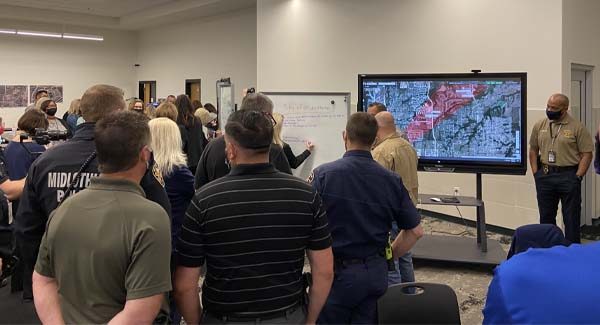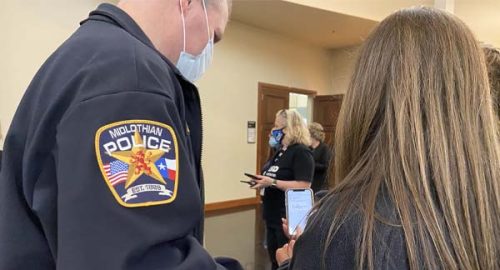Imagine you are a first responder, and you were just alerted of an emergency at a local elementary school. You get on scene and a staff member tells you that there is a critically injured student in Mr. Smith’s room located in the science wing. Before you can even attempt to assist the student, you have to stop and ask, “Where is the science wing and what room number is Mr. Smith’s?”
Situations like these—ones that ultimately result in delayed or chaotic school emergency response—are more likely to happen when the school and its local first responders are unfamiliar with one another and don’t have the tools needed for an aligned response.
In a Raptor webinar, K-12 safety experts discussed how schools and public safety groups can build intentional relationships for coordinated school safety processes. Below are some of their tips. To listen to the full conversation, click here.
Involve First Responders in Drills and Exercises
Schools and their local first responders “need to have an integrated process and integrated response, especially during a critical incident at a school,” Kevin Burd, a 23-year police veteran and owner of Priority of Life Training and Consulting says.
Involving law enforcement and first responders in your drills is the perfect opportunity to establish a relationship and get feedback on your processes. It also enables both parties to talk through various scenarios, like what a lockdown, medical emergency, or evacuation would look like. School staff and first responders should meet soon after each drill to discuss lessons learned and areas that need improvement.
“It’s amazing what you can learn from both sides [during these conversations],” Kevin shares. “I’ve seen situations where first responders don’t know what schools are doing and then vice versa” where schools have not considered what response looks like from a first responder’s point of view.

Raptor staff visited Midlothian ISD (TX) for a reunification drill. Raptor, district staff, city staff, and first responders discussed plans and what resources are available to improve emergency response. Watch the full video here.
“Having [these safety] drills and conversations and bringing everybody [into the process] helps build those relationships,” Burd claims. By involving first responders, they will become more familiar with your campuses, and your school community will become more familiar with law enforcement. This is critical when an actual crisis occurs, as it makes the response go smoother and safer.
Speak the Same Language
Chris Wilderman, Director of Safe and Sustainable Environments for Adams 12 Five Star Schools in Thornton, Colorado, says, “One of the foundational pieces … is making sure that [the school and first responders] are all speaking the same language.” This includes local and neighboring agencies, as they will all respond to critical incidents at the school.
If the agencies are driven by different school emergency response protocols—ALICE versus “I Love U Guys,” for instance—it can cause confusion. “You have to … have open communication with these agencies to make sure [everyone is] on the same page. If you haven’t established the protocol you are going to follow, it has the potential for disaster,” Wilderman warns.
A powerful K-12 emergency management software can eliminate the challenge of coordinating safety protocols across various agencies and campuses. The best solutions are customizable to your emergency protocols and are accessible to first responders and staff. This helps ensure everyone is following your latest processes and speaking the same language during response and recovery.
Clearly Communicating
“After almost every incident when we debrief and talk about what went right and what went wrong… the top three issues are consistently around communication,” Stacy Avila, Adjunct Trainer for The “I Love U Guys” Foundation says. “You have to establish your communication plans way in advance. If we’re trying to do that during the incident, you’ve already failed.”
Communication plans include knowing the means and methods of how you will communicate with everyone involved. Avila recommends schools consider what tools they have available and practice using the tools before an incident happens. The school’s emergency management software should enable all users, including first responders and staff, to stay connected through real-time group messaging and access detailed school maps directly from any web-enabled device.
Aligned communication also means knowing what roles each person plays. “If you have not established who is in charge of what [part of response and recovery] ahead of time, it is a recipe of disaster,” Wilderman says.
Have a Better Coordinated Response with Raptor
The more you collaborate with and understand law enforcement—and the more they understand your school—the better your school safety and emergency response will be. Emergency response also depends on having the right tools.
With Raptor Emergency Management, schools can protect their students and staff and be in complete control during drills, active incidents, and reunifications. Schedule a personalized demo to learn more.





